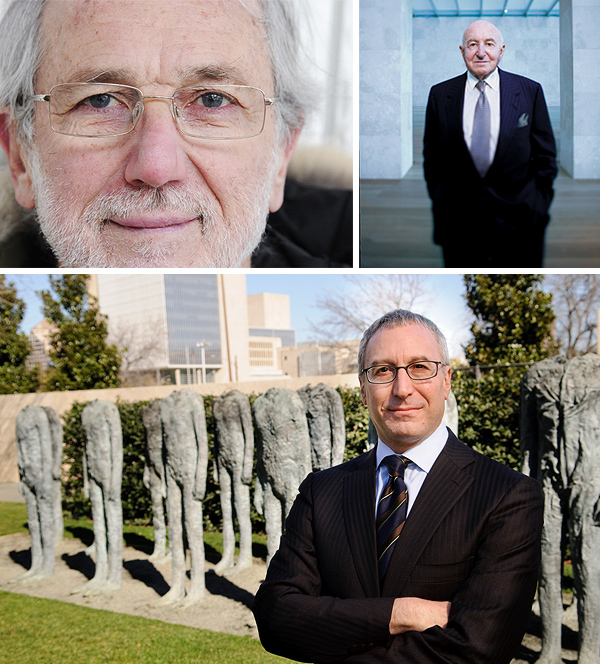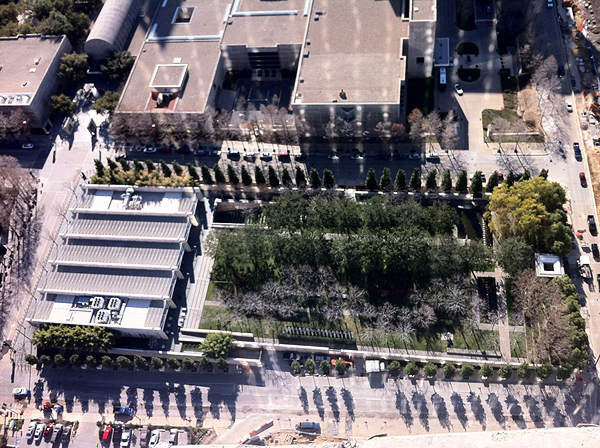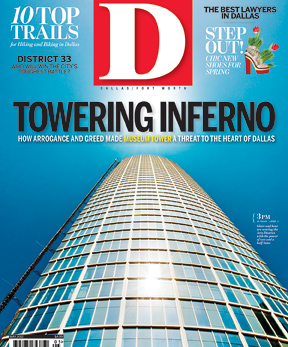Criswell laughs and agrees. “Look,” he says, “I got hit by a tidal wave.” In other words, he couldn’t have foreseen the Texas real estate crash.
I point out that a search of his name brings up a series of troubled deals around the world. There was the complicated scheme in Puerto Rico that involved the issuance of government bonds and a mysterious loan that never materialized from professional golfer Chi Chi Rodriguez. The deal ended up in court. There was the Four Seasons hotel in Dublin, Ireland, that ran tens of millions over budget and went into receivership.
In each instance, Criswell tries to set the record straight. The Four Seasons in Ireland, for example, was a successful project. He says 97 percent of the capital came from large Irish banks, the remaining 3 percent from wealthy private investors insulated from losses by a loophole in Irish law. “The investors did really well,” he says. “The banks did not do well. The economy turned sour, and everything in Ireland turned to goo.”

People have told Criswell that he ought to clean up some of the untruths about him floating around on the internet. “I’ve never found that it’s a particularly valuable thing to do,” he says. His development and consulting firm, Criswell Radovan, doesn’t have a website. “Anybody who wants to know the truth, I’m happy to talk to them. And I’m happy to give them references.”
Tettamant met Criswell seven years ago when the police and fire fund invested $35 million with Criswell Radovan in two related Napa Valley projects, Aetna Springs and Lake Luciana. Criswell wanted to build a golf course. As it turned out, he wanted to build it on land that is preserved for agricultural use. The matter wound up in court.
In any case, what Tettamant knew with certainty was that if Criswell could build the acclaimed Fountain Place, then he could help out the police and fire fund with Museum Tower. He hired Criswell as a consultant in 2006. At the time, the police and fire fund had only about $30 million committed to the deal. So the first big change to the project was that it grew taller and more expensive.
“The fund was disappointed with the direction under Sughrue,” Criswell says. “Their designs didn’t recognize the significance of the site. I think the people who are involved will tell you that they were trying to be modest, and they didn’t want to, you know, do something that might show up the other great Pritzker award-winning people and all that stuff.”
Criswell brought onboard Scott Johnson, a Los Angeles-based architect. The two had been introduced in Napa by Michael Mondavi, for whom Johnson built the Opus One winery. Johnson built a clubhouse for Criswell at the historic Aetna Springs golf course. And he designed the Museum Tower we see today.

Remember the covenant that Graham Greene had Sughrue sign when he bought the dirt under Museum Tower, the covenant that limited the reflectivity of the glass? That covenant expired in 2008, a little more than a year after Ray Nasher died and just as the police and fire fund was pouring more money into the Museum Tower project to make it bigger. The glass that towers 42 stories today is 200 percent more reflective than would have been allowed by that covenant. It remains unclear whether Johnson ever did a light and heat study. Neither he nor his local architect partners, the firm Gromatzky Dupree & Associates, returned phone calls or email. Neither Tettamant nor Criswell could say whether a study had been done.
The second big change to the project came in 2010 when the police and fire fund financed—or, if you prefer, got the bank to finance—the full $200 million cost of construction. At that point, the fund took full control of Museum Tower from Sughrue and his partners. The four men were relegated to service contracts to develop the project (manage sales, oversee contractors, etc.) and had their equity returned to them, but they had to report to Criswell, who assumed the role of owner’s representative, the man in charge of the project.
“No developer ever wants to cede control of a project,” Sughrue says, choosing his words carefully. “That’s not how we’re wired. It’s not why we’re in this business. But at the time, we as a development group did what it took to protect the initial investment of all those involved and the vision that some day there’d be an extraordinary building that we’d be proud to call Museum Tower.”
When I ask him how he feels now, looking back at the decision to hand over control of Museum Tower to Criswell and the police and fire fund, he lets the question hang in the air for 10 seconds. Then he offers a one-word answer: “Heartbroken.”
After Jeremy Strick told the people at Museum Tower that he had a serious problem with light blazing into the Nasher’s galleries, the two sides began a series of meetings in the museum’s boardroom. It’s an airy space with white oak floors. One entire wall is glass, providing a view of the garden.
Members of the original group of Museum Tower developers came to the first two meetings, where nothing much got accomplished. “We felt that we needed action,” Strick says. “And we realized that they hadn’t addressed the essential issue and that that group wasn’t going to, that other people had to be engaged.”
Strick emailed Boeckman with his concerns, and Boeckman told him that the ball was in Johnson’s court, and he hadn’t heard from the architect yet. Strick knows Johnson personally. Before arriving at the Nasher, Strick was the director of the Museum of Contemporary Art in Los Angeles for nine years. Their kids went to school together. So Strick called Johnson. “No, I’m not working on it,” Johnson said. “I always assumed I would. I’d better get to Dallas and look at this in person.”
At the third meeting, in November, as matters grew more serious, only one of the original developers attended. In place of the other developers, Tettamant, Criswell, and an attorney for the police and fire fund came to the meeting. Scott Johnson flew in for it. David Haemisegger was at the table. He is Ray Nasher’s son-in-law, president of the museum’s board, and president of NorthPark Management Company. Haemisegger had met Tettamant six years earlier, when the police and fire fund made a short-term loan to NorthPark for its expansion.

After Haemisegger made introductory remarks, Tettamant said, “I’d like to know what you can do from your side.”
“It surprised me,” Strick says of Tettamant’s opening line. “We were talking about one of the great buildings in the world. To immediately suggest that we change it seemed to me that he did not appreciate what was at stake.”
Strick’s mood did not improve when, later in the meeting, Criswell said the problem could be remedied if the Nasher would grow some tall trees.
The two sides eventually agreed to commission their own light and heat studies and to meet when they were finished. Museum Tower hired RWDI, out of Canada, and the Nasher hired Arup, the London-based engineering firm that worked with Piano to design the Nasher’s aluminum sunscreen.
On March 7, the two sides again gathered in the Nasher’s boardroom. This time, none of the original developers was present. Johnson introduced Museum Tower’s report and turned over the meeting to an RWDI engineer on speakerphone from Vancouver. The engineer walked everyone through Museum Tower’s report, which offered findings that diverged wildly from the Nasher’s.
The Nasher’s computer modeling found that the reflectivity of the glass creates patches of radiation that are 150 percent more intense than normal direct sunlight. Imagine the Sun growing to two and a half times its size. Direct measurements taken on a cloudless, 78-degree March day showed that the reflected light raised the lawn’s temperature to 103 degrees. For most plants, 115 degrees is lethal. Even at much lower temperatures, they can sustain damage if temperatures fluctuate too quickly for them to adjust. The direct measurements were taken after the March 7 meeting, but the Nasher’s report based just on computer modeling was clear: the year-round reflections posed a threat to both the galleries and the garden. To a lesser extent, they affect other parts of the Arts District. And, given the size of the garden and the special nature of Piano’s roof, there was no viable solution at the Nasher for the problem.
The Museum Tower report, on the other hand, said that the increase in radiation would be less than 25 percent, only a sixth of the Nasher’s predicted gain. The report concluded that to stop light from ruining the galleries, the Nasher should install “shading devices.” The report did not make a recommendation for the garden because it predicted that any impact would be minor.
The reason for the differing conclusions? RWDI used the wrong data. Museum Tower’s glass is 300 times more reflective than the glass RWDI plugged into its computer model.
Tettamant and Criswell would later say that the mistake happened because theirs was a draft report, but each of the report’s 15 pages is labeled “final report.”
In the Nasher boardroom, the meeting grew tense when the Arup engineer presented the Nasher’s suggested slate of fixes, each of which involved altering Museum Tower. With both sides agreeing that a reglazing or replacement of the windows wouldn’t do the trick, the Nasher recommended affixing a brise soleil, a system of shading louvers or a skin that would extend beyond the glass facade.
“That would be a building,” Johnson said, “but that’s not our building.”
Vel Hawes, the owner’s representative who worked with Ray Nasher to build the museum, spoke up: “Excuse me, but you’re saying we should change our roof. That’s not our building.”
At some point, Strick had had enough. He pushed back his chair and stood up. “As far as we’re concerned, you guys created the problem,” he said. Strick is a soft-spoken man of enormous restraint. He’d clearly hit the breaking point. “It’s your problem to fix. We’re not going to touch our building. We’re not going to study a solution on our side. That’s the end of the discussion.”
The other seven people remained seated. An awkward silence filled the room. Then Criswell broke it.
“Jeremy, we all agreed we were going to study these things,” he said. “One of the things that may come out of the study is that the design of those cones [the north-facing oculi] may have inadvertently or in some other way, you know, turned out to actually have reflections
coming in when Renzo sold you a bill of goods that said it wouldn’t.”
That’s how Criswell remembers the exchange weeks later, when he describes it to me, unprompted. He is clearly proud that he stood up to Strick, a man who, he says, isn’t accustomed to having people talk back. And he’s proud that he insulted Renzo Piano.
How, then, does this game of chicken play out? More than one person with enough experience to speculate has told me that a fix on the Museum Tower side, a brise soleil, or re-skinning of the building, could cost $20 million.
I asked Fred Kent about that figure. He’s the founder of a 32-year-old New York City nonprofit called the Project for Public Spaces. The
New York Times called him “an urban anthropologist and space doctor.” Kent is helping the Bass family reimagine Sundance Square in Fort Worth, and he travels through Dallas every few weeks.
“Twenty million?” he says. “That’s fine. When you look at it in the public realm, the capital spent by a city around places that are important, that’s a sacred value. To go against that is a crime.”
If it is a crime, how culpable is the city of Dallas for allowing it to occur? Legally, the city may have no liability. The police and fire fund is a separate entity. Observers may question, however, why a succession of City Councils has allowed the fund to become the riskiest in the nation without publicly calling to account its management and its protocols. Now one of that fund’s investments—made riskier by increasing its height and cost—could well damage irreparably two of the city’s prized private donations, the Nasher and Warren Park. The total investment in the Arts District by private individuals, including Ray Nasher and Kelcy Warren, exceeds $500 million.
The controversy surrounding the fund’s management of Museum Tower—whose name has become a standing irony—is unlikely to aid in its success as an investment. So far, 16 units out of approximately 100 have been sold. The most likely purchasers of units are art lovers who want to be in the center of a bustling Arts District. The stigma of harming the Nasher and the park might be repellent to the very people who are needed to recoup the fund’s investment. And that raises another question. Will the city be left with a nearly empty white elephant in the very heart of the district?
“The idea of Ray Nasher to make in the center of the city—in the center, not out in the country, in the center—to make a jewel, a place of wonder, a place of joy, a place of beauty, this is a great idea,” Renzo Piano says.
“I kept making a joke with Ray. I kept telling him, ‘Ray, this is a mad idea.’ Of course, I used the word ‘mad’ in a positive sense. It’s the right kind of madness. It was a generous and great idea. Right there, right there in the middle of city life. This is where art should be. This is where beauty must be. Right there in the center of the city, absolutely unexpected, creating a sense of surprise.”
The surprise, as it turns out, is the glaring light and searing heat generated by the power of two and a half Suns.
Write to [email protected].






